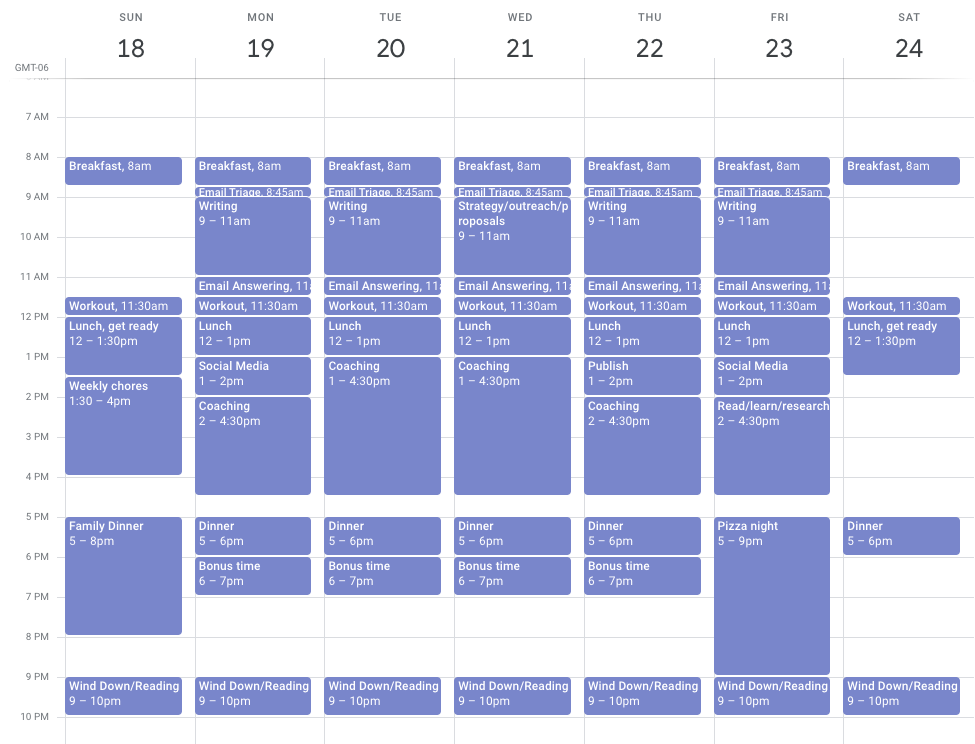Time-Blocking and Imagining Your Ideal Week
Learn how to map out your ideal week and get started using my handy template.

**This post was originally published on August 19, 2018, but has been updated and republished.
Entrepreneurs, especially those with new or growing businesses, often have a fly-by-the-seat-of-your-pants approach to life. The problem with this is that it is reactive. Weeks fly by as they are consumed by the fire of the day (or hour). There is a lack of planning and strategy about how time is spent. There is no intention, or rather, there are good intentions but no plan or process to help execute those intentions.
Time-blocking is a way to help you set your intentions for a week: you block out sections of time for certain types of tasks or a particular task. It creates a powerful visual of the things that you are spending your time on, want to spend time on, and how they are distributed across your week. It helps you see the spaces (or lack thereof) in your schedule and take an intentional approach to fit in your personal and professional priorities.
The first step I recommend when you are preparing to start time-blocking is to imagine and time-block your ideal week. Your ideal week is how you would spend your time if the stars aligned and everything went exactly as you planned. No emergencies, no interruptions, no unplanned events, no distractions. Perfect.
The benefit of thinking through your ideal week is that it forces you to be reflective about what you are ACTUALLY spending time on. Some things you spend time on are necessary but need to be intentionally weighed against what you WANT to be spending time on, and aren’t.
Steps to creating your ideal week:
Brainstorm the top activities that you ACTUALLY spend time on.
- Think about your daily routine and look back through your calendar for the last few months.
- Think about the things you read and watch.
- Think about how often you are checking social media.
Brainstorm the top activities that you WANT to spend time on.
- Think about how often you get together with your friends or spend quality time with your family and partner.
- Think about the things you want to do for self-care (if anything) like exercise or reading or recreational activities.
- Think about the things you want to do for self-growth like listening to business podcasts or reading educational books.
Map it out by hand, in a spreadsheet, or create a separate calendar
- Map out normal day-to-day life things like eating, fitness, or travel time. Also, include any recurring commitments you have like standing meetings.
- Add the things you brainstormed that you have to do and will always be part of your week. See where the gaps are.
- Fill in the gaps with the things you brainstormed that you want to do.
- Use the picture you have created of your ideal week as the basis for time-blocking an actual week.
Example: My ideal week
This is an example of my ideal week:

Things of note:
- I prefer to take all my coaching sessions in the afternoon. If I don't have a coaching session scheduled this is also the time I take other meetings.
- I prefer to write and work on strategy in the mornings because that is when I am most fresh and can do deep thinking work.
- I make sure there is time for me to work out every day.
- Friday nights (aka Pizza night) are protected time with my husband.
- I try to triage my email first thing, only spend 15 minutes on it, and then leave any longer answers until after my writing or strategy work.
- I try to do mundane or brainless work after dinner if I feel like it.
- I leave my evenings open, knowing I am likely to add dinner with a friend or a business event.
Do my weeks always look like this? Nope. Do I try to make my weeks look like this? Yep.
*Note: I don't have kids so for parents out there, your ideal week will of course look different. When you are filling your ideal week out, think about adding bedtime and any recurring activities.
Map your actual week on top of your ideal week
Once you have your ideal week mapped out you can take a look at your actual week and see how it fits.

For example. I like to spend 15 minutes on Sunday evenings taking a look at my TODO list and time-blocking it into my ideal week sections. The idea is to take into account what I have already committed to in the week ahead. Then I set realistic expectations for when I am going to work on certain tasks and what is achievable.
Your ideal week is something to aspire to
Your ideal week is not likely to be an accurate representation of a real week. There are too many variables outside of our control for it to be a reasonable expectation. You get sick, a project gets delayed, you overbook with meetings, you have a deadline, your kid is in a hockey tournament, your laptop dies, etc. Life is going to happen and throw you off.
Your ideal week is something to aspire to. It is a reminder for you to come back to when your best-laid plans go sideways. It is the basis for laying out your week intentionally with actual time-blocks which include some of the things you WANT to be doing. It is a way to take a breath each week and think about how you are going to work to make this week better than the last.
Ideal week spreadsheet template
If you prefer a spreadsheet to start, you can use this template to create your ideal week or try mapping it out in your actual online calendar. Share it with someone important and ask them to do it too. Make it a conversation. :)
Share
Ashley Janssen

Productivity consultant, writer, speaker, serial entrepreneur, chaos calmer, introvert, cat-lady. Lover of books, fitness, old fashioned’s, basketball, and video games.
Follow me on
Twitter
or
LinkedIn.
Hire me for
1 on 1 productivity consulting
or
speaking.
Related articles

Why Are You Productive For "Only" 5-6 Hours Each Day?

When Is It Enough?


Comments ()